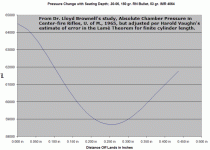Papajoe222
Inactive
I'm fairly new to reloading, so please bare with me.
I'm having trouble finding any info on the Hornady GMX bullets. What I have been able to find are references to using the SST data for load work-up. There doesn't appear to be any, easily available info on OAL. Everything I've been able to find refers to monolithic bullets in general and the consensus is to start well off the lands (.050). With this bullet, I end up with a compressed load @ 1.5gr over the recommended staring charge.
If I'm avoiding excessive pressure by seating well off the lands, am I not defeating that with a compressed load? If anyone has experience with these, any insight would be appreciated.
I'm having trouble finding any info on the Hornady GMX bullets. What I have been able to find are references to using the SST data for load work-up. There doesn't appear to be any, easily available info on OAL. Everything I've been able to find refers to monolithic bullets in general and the consensus is to start well off the lands (.050). With this bullet, I end up with a compressed load @ 1.5gr over the recommended staring charge.
If I'm avoiding excessive pressure by seating well off the lands, am I not defeating that with a compressed load? If anyone has experience with these, any insight would be appreciated.

